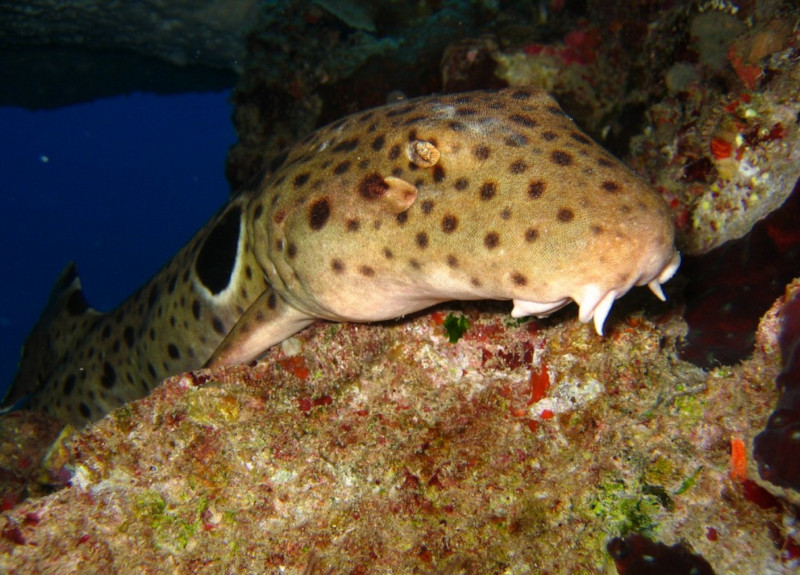
Epaulette Shark Facts
- The descriptive term of Epaulette Shark serves as the common name for an unusual variety of shark. Its scientific name, however, is the somewhat difficult to pronounce term of Hemiscyllium ocellatum. By either name, though, it’s a fascinating species.
- Originally, it bore a different, and slightly more pronounceable, official name. That term, assigned during its first scientific recognition, was Squalus ocellatus. The French naturalist Pierre Joseph Bonnaterre bestowed that initial title in 1778.
- It’s best known, though, for the astounding ability it evolved. This variety of shark literally, and frequently, walks across the ocean floor, or even dry land! The fish manages this locomotion by using its fins to undulate its way across the seabed.
- Fortunately, the population base of the marvelous Epaulette Shark appears to be both sufficient and comparatively stable. The IUCN, therefore, presently lists this marvel of Nature as Least Concern. That status appears on its Red List of Threatened Species.
- This amazing fish nevertheless faces at least some potential threats to its continued existence. Like every other living thing on the planet, climate change could pose a serious threat in the near future. For the moment, though, few other factors threaten it.
Related Articles
Epaulette Shark Physical Description
The visually surprising Epaulette Shark constitutes a mesmerizing species, in the opinions of some individuals. It does not, however, earn this distinction due to sheer size. That’s because this wonderful animal actually ranks as a very small variety of shark.
Individuals of both genders also attain an average length of between 27 – 35 in (70 – 90 cm). Exceptional specimens, though, grow to as much as 42.1 in (107 cm). Yet, unlike many related species, this fish does not display any noticeable degree of sexual dimorphism.
The body of the Epaulette Shark develops as quite slender, and relatively elongated. Its snout, meanwhile, appears rounded and very short in structure. It also possesses between 26 – 35 rows of teeth in its upper jaw, along with 21 – 32 rows of teeth within its lower jaw.
The most noteworthy feature is the one that’s the source of the common name. That’s the presence of a large black spot behind each pectoral fin, surrounded by a white ring. The rest of the body also displays a brownish to beige shade, with brown spots and bands.
- Kingdom: Animalia
- Phylum: Chordata
- Class: Chondrichthyes
- Order: Orectolobiformes
- Family: Hemiscylliidae
- Genus: Hemiscyllium
- Species: H. ocellatum
Epaulette Shark Distribution, Habitat, and Ecology
Sadly, the Epaulette Shark has one factor limiting its potential for successful competition with related species. That’s the fact that it only appears to live in a highly restricted portion of the globe. That range further consists of parts of the western Pacific Ocean.
More specifically, its only confirmed range extends from the northern coast of Australia to the southern shores of New Guinea. Unconfirmed reports, however, indicate the possibility that a small population may also exist around Sumatra, Malaysia, and the Solomon Islands.
Like many of the other small varieties, this particular shark evolved as a bottom-dwelling species. In its case, though, the creature rarely appears at depths greater than 131 ft (40 m). It also principally inhabits regions of coral reef, including the Great Barrier Reef.
Like virtually all known shark types, the small yet impressive Epaulette Shark evolved as a carnivore. Its own size, however, restricts its choices of prey. These mainly consist of various small fish and crustaceans. But, it also occasionally feeds on polychaete worms.
Regardless of its prey of choice at a given moment, it most commonly hunts during period of low tide. Apart from this, its greatest periods of activity typically occur at dusk and dawn. Its own predators, meanwhile, include other, larger sharks, and grouper.
Species Sharing Its Range
Check out our other articles on 4 Magnificent Land Mammals of Mexico, Hyacinth Macaw, Saint Mary’s Islands, Kapok Tree, Salt Creek Tiger Beetle, Apple of Sodom, Satanic Leaf-Tailed Gecko
